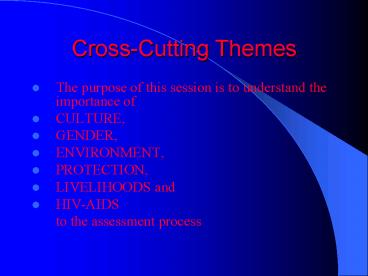CrossCutting Themes - PowerPoint PPT Presentation
1 / 23
Title:
CrossCutting Themes
Description:
Public vs private. Access to productive assets. Inheritance. Decision-making. Social networks ... Are gender issues incorporated into all parts of the proposal? ... – PowerPoint PPT presentation
Number of Views:26
Avg rating:3.0/5.0
Title: CrossCutting Themes
1
Cross-Cutting Themes
- The purpose of this session is to understand the
importance of - CULTURE,
- GENDER,
- ENVIRONMENT,
- PROTECTION,
- LIVELIHOODS and
- HIV-AIDS
- to the assessment process
2
Culture and Disasters
- Are our programs adapted to the beliefs and
institutions of the affected populations?
3
What is culture?
- A learned system of ways to behave and interpret
reality - Beliefs, institutions typical of a population or
community at a given time
4
How Culture Intersects with Humanitarian
Assistance
- Every disaster actor has a particular culture
(affected populations donors, donor governments
UN agencies, PVOs NGOs host governments) - Cultural beliefs and attitudes will influence how
assistance is provided, received, and interpreted
5
Why Knowledge of Culture is Important in Disaster
Assistance
- Beliefs/ attitudes can hinder OR help
- Insufficient/incorrect knowledge can lead to
inappropriate assistance - Solid understanding can help ensure effective
programming
6
Examples of Disastrous Culture Clashes
- Focusing on the most vulnerable vs the most able
in Southern Sudan - Setting up municipal elections in Kosovo
- Other examples?
7
Implications for programming
- What cultural issues must be addressed for the
program to be successful? - Are they addressed in effective ways?
8
Social Context Gender
- Is knowledge of GENDER relations and issues
integrated into our programs?
9
Definition of Gender
- GENDER refers to the socially constructed
differences among male and female adults,
adolescents, and children
10
Some crucial differences among the groups
- Public vs private
- Access to productive assets
- Inheritance
- Decision-making
- Social networks
- Status
- Rights
11
Key Gender Concept 1
- Disasters often have different effects on the
categories of female and male members of a
population
12
Examples of differential effects
- Sudanese boys in Kenya
- Rwandan women farmers
- Participant examples
13
Key Gender Concept 2
- Disasters often affect individuals WITHIN each
group differently according to certain variables
14
What to assess in the field
- How has the disaster affected
- Which gender group(s) need assistance in
priority - Roles and responsibilities, needs and capacities
- How goods and services should be provided?
15
Implications for Programming
- Are the needs and capacities of the different
gender groups described/analyzed adequately? - Are gender issues incorporated into all parts of
the proposal?
16
Environment the Natural Context of Disasters
17
Definitions
- The Natural Environment
- Ecosystems
- Natural Resources
18
Inter-relationshipsbetween humans and the
natural environments they live in
- Humans impacts on nature
- Positive
- Negative
- Natures impacts on humans
- Positive
- Negative
19
When Good Humans Go Bad
- Environmental Degradation and Disasters
- Environmental degradation and change may increase
the severity and impact of disasters - Deforestation and desertification
- Water and air pollution
- Global warming
20
Tools for AssessmentIndicators of Environmental
Degradation
- Decreased agricultural production
- Loss of species/biodiversity
- Settlement in marginal lands
- Increased erosion and sedimentation
- Increase in disease epidemics
21
How can degradation be prevented or reversed?
- Environmentally sensitive development
- Environmentally sensitive disaster response
- Post-disaster environmental rehabilitation
22
Implications for Programming
- What environmental issues need to be addressed
for the program to be effective? - Could the proposed activities have negative
environmental impacts? If so, how will they be
mitigated?
23
Assessment Tool
- REA Rapid Environmental Assessment
- supported by OFDA
- method and training
- applications































